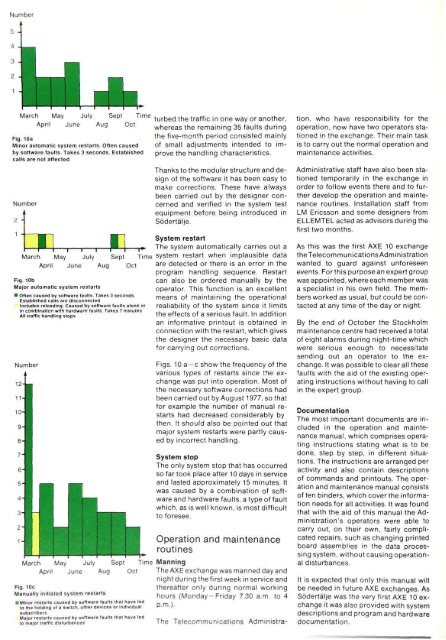ericsson review - ericssonhistory.com
ericsson review - ericssonhistory.com
ericsson review - ericssonhistory.com
You also want an ePaper? Increase the reach of your titles
YUMPU automatically turns print PDFs into web optimized ePapers that Google loves.
Fig. 10a<br />
Minor automatic system restarts. Often caused<br />
by software faults. Takes 3 seconds. Established<br />
calls are not affected<br />
Fig. 10b<br />
Major automatic system restarts<br />
• Often caused by software faults. Takes 3 seconds.<br />
Established calls are disconnected<br />
Includes reloading. Caused by software faults alone or<br />
In <strong>com</strong>bination with hardware faults. Takes 7 minutes<br />
All traffic handling stops<br />
March May July Sept Time<br />
April June Aug Oct<br />
Fig. 10c<br />
Manually initiated system restarts<br />
• Minor restarts caused by software faults that have led<br />
to the holding of a switch, other devices or individual<br />
subscribers<br />
Ma|or restarts caused by software faults that have led<br />
to major traffic disturbances<br />
turbed the traffic in one way or another,<br />
whereas the remaining 35 faults during<br />
the five-month period consisted mainly<br />
of small adjustments intended to improve<br />
the handling characteristics.<br />
Thanks to the modular structure and design<br />
of the software it has been easy to<br />
make corrections. These have always<br />
been carried out by the designer concerned<br />
and verified in the system test<br />
equipment before being introduced in<br />
Sodertalje.<br />
System restart<br />
The system automatically carries out a<br />
system restart when implausible data<br />
are detected or there is an error in the<br />
program handling sequence. Restart<br />
can also be ordered manually by the<br />
operator. This function is an excellent<br />
means of maintaining the operational<br />
readability of the system since it limits<br />
the effects of a serious fault. In addition<br />
an informative printout is obtained in<br />
connection with the restart, which gives<br />
the designer the necessary basic data<br />
for carrying out corrections.<br />
Figs. 10 a—c show the frequency of the<br />
various types of restarts since the exchange<br />
was put into operation. Most of<br />
the necessary software corrections had<br />
been carried out by August 1977, so that<br />
for example the number of manual restarts<br />
had decreased considerably by<br />
then. It should also be pointed out that<br />
major system restarts were partly caused<br />
by incorrect handling.<br />
System stop<br />
The only system stop that has occurred<br />
so far took place after 10 days in service<br />
and lasted approximately 15 minutes. It<br />
was caused by a <strong>com</strong>bination of software<br />
and hardware faults, a type of fault<br />
which, as is well known, is most difficult<br />
to foresee.<br />
Operation and maintenance<br />
routines<br />
Manning<br />
The AXE exchange was manned day and<br />
night during the first week in service and<br />
thereafter only during normal working<br />
hours (Monday-Friday 7.30 a.m. to 4<br />
p.m.).<br />
The Tele<strong>com</strong>munications Administration,<br />
who have responsibility for the<br />
operation, now have two operators stationed<br />
in the exchange. Their main task<br />
is to carry out the normal operation and<br />
maintenance activities.<br />
Administrative staff have also been stationed<br />
temporarily in the exchange in<br />
order to follow events there and to further<br />
develop the operation and maintenance<br />
routines. Installation staff from<br />
LM Ericsson and some designers from<br />
ELLEMTEL acted as advisors during the<br />
first two months.<br />
As this was the first AXE 10 exchange<br />
the Tele<strong>com</strong>munications Administration<br />
wanted to guard against unforeseen<br />
events. For this purpose an expert group<br />
was appointed, where each member was<br />
a specialist in his own field. The members<br />
worked as usual, but could be contacted<br />
at any time of the day or night.<br />
By the end of October the Stockholm<br />
maintenance centre had received a total<br />
of eight alarms during night-time which<br />
were serious enough to necessitate<br />
sending out an operator to the exchange.<br />
It was possible to clear all these<br />
faults with the aid of the existing operating<br />
instructions without having to call<br />
in the expert group.<br />
Documentation<br />
The most important documents are included<br />
in the operation and maintenance<br />
manual, which <strong>com</strong>prises operating<br />
instructions stating what is to be<br />
done, step by step, in different situations.<br />
The instructions are arranged per<br />
activity and also contain descriptions<br />
of <strong>com</strong>mands and printouts. The operation<br />
and maintenance manual consists<br />
of ten binders, which cover the information<br />
needs for all activities. It was found<br />
that with the aid of this manual the Administration's<br />
operators were able to<br />
carry out, on their own, fairly <strong>com</strong>plicated<br />
repairs, such as changing printed<br />
board assemblies in the data processing<br />
system, without causing operational<br />
disturbances.<br />
It is expected that only this manual will<br />
be needed in future AXE exchanges. As<br />
Sodertalje was the very first AXE 10 exchange<br />
it was also provided with system<br />
descriptions and program and hardware<br />
documentation.
















